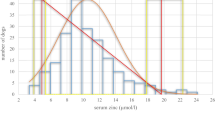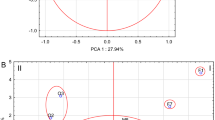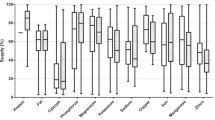Abstract
The serum levels of copper, zinc, iron, manganese, nickel, cadmium, cobalt, sodium, potassium, calcium, and magnesium were determined in seven different breeds of dogs: Pointer, Poodle, Setter, Labrador Retriever, Golden Retriever, German Shepherd, and Mallinois. Only slight variations were found among the different breeds, and the results presented in this study can be used for laboratory studies in veterinary science.
Similar content being viewed by others
References
Coles EH (1986) Veterinary clinical pathology, 4th edn. Saunders, Philadelphia, PA, p 231–240
Bunce HW, Chiemchaisri Y, Phillips PH (1962) The mineral requirements of the dog. IV. Effect of certain dietary and physiologic factors upon the magnesium deficiency syndrome. J Nutr 76:23–29
Committee on Mineral Toxicity in Animals (1980) Mineral tolerance of domestic animals. National Academy of Science, Washington, DC
Underwood EJ (1977) Trace elements in human and animal nutrition, 4th edn. Academic, London
Golden MH (1988) Trace elements in human nutrition. Hum Nutr Clin Nutr 36:448–455
Chester JK (1978) Biochemical functions of zinc in animals. World Rev Nutr Diet 32:135–164
McDwell LR, Condrad JH (1989) Detection of mineral deficiencies and toxicities for graning livestock. In: Trace ’89 Proceeding, Cukurova University Medical Faculty, Adana, Turkey, pp 69–80
Lowe JA, Wiseman J, Cole DA (1994) Zn sources influence Zn retardation in hair growth in the dog. J Nutr 124:2575S
Kuhlman G, Rompala RE (1998) The influence of dietary sources of zinc, copper and manganese on canine reproductive performance and hair mineral content. J Nutr 128:2603S–2605S
Mert N (1996) Veteriner Klinik Biyokimya, U.U. Guclendirme Vakfı Yayın 12 (in Turkish)
Morton S, Roberts DJ (1993) University of Bristol, Unicam AAS methods. Manual issue 2, 05/93
SAS (2006) User’s guide: statistics. SAS Institute, Carry, NC
Taylor AW, Walker LS (1984) Trace element analysis-obtaining good result. In: Trace ’89 Proceeding, Cukurova University Medical Faculty, Adana, Turkey, pp 1–9
Vohara SB (1983) Medical elementology. Inst Hist Med Rev Res New Delhi
Adamama-Moraitou K, Rallis T, Papasteriadis A, Roubies N, Kaldrimidou H (2001) Iron, zinc, and copper concentration in serum, various organs, and hair of dogs with experimentally induced exocrine pancreatic insufficiency. Dig Dis Sci 46:1444–1457
Muller E (2005) Clinico-chemical parameters in the dog. Kleintierpraxis 50:785–788
Author information
Authors and Affiliations
Corresponding author
Rights and permissions
About this article
Cite this article
Mert, H., Mert, N., Dogan, I. et al. Element Status in Different Breeds of Dogs. Biol Trace Elem Res 125, 154–159 (2008). https://doi.org/10.1007/s12011-008-8160-5
Received:
Accepted:
Published:
Issue Date:
DOI: https://doi.org/10.1007/s12011-008-8160-5




